RBSE Solutions for Class 11 Physics Chapter 3 Motion in a Straight Line
Rajasthan Board RBSE Solutions for Class 11 Physics Chapter 3 Motion in a Straight Line Textbook Exercise Questions and Answers.
Rajasthan Board RBSE Solutions for Class 11 Physics in Hindi Medium & English Medium are part of RBSE Solutions for Class 11. Students can also read RBSE Class 11 Physics Important Questions for exam preparation. Students can also go through RBSE Class 11 Physics Notes to understand and remember the concepts easily.
RBSE Class 11 Physics Solutions Chapter 3 Motion in a Straight Line
RBSE Class 11 Physics Motion in a Straight Line Textbook Questions and Answers
Question 3.1.
In which of the following example of motion can the body be considered approximately a point object:
(a) A railway carriage moving without jerks between two, stations?
(b) A monkey sitting on the top of a man cycling smoothly on a circular track?
(c) A spinning cricket ball that turns sharply oh hitting the ground.
(d) A tumbling beaker that has slipped off the edge of a table?
Answer:
(a) The railway carriage moving without jerks between two stations is considered as point object since the distance between two stations is much greater as compared to the size of the carriage.
(b) The monkey sitting on the top of a man cycling smoothly on a circular path (track) can be considered as a point object because the distance covered by the cyclist is much greater than the size of monkey sitting on it.
(c) The spinning cricket ball that turns sharply on hitting the ground can not be considered as point object because as the spinning of ball is not so smooth such-that the distance through which it turns is not much larger than the size of the ball.
(d) The tumbling beaker that has slipped off the edge of table cannot be considered as point object because the size of the beaker is not negligible as compared to the height of the table.

Question 3.2.
The position-time (x - t) graphs for two children A and B returning from their school O to their homes P and Q respectively are shown in figure. Choose the correct entries in the brackets below:
(a) (A/B) lives closer to the school than (B/A)
(b) (A/B) starts from the school earlier than (B/A)
(c) (A/B) walks faster than (B/A).
(d) A and B reach home at the (same/different) time.
(e) (A/B) overtakes (B/A) on the road (once/twice).
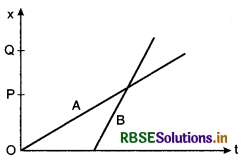
Answer:
(a) As distance covered by B is greater than A i. e, OQ > OP, so A lives closer to the school than B.
(b) As t = 0 for A, so t has some finite value for B. Therefore, A starts from the school earlier than B.
(c) Here the slope of x - t graph for B is greater than that for A In case of uniform motion velocity is equal to slope of the x - t graph. So B walks faster than A.
(d) As shown in the x - t graphs for A and R the value of t is same corresponding to the points P and Q. Thus both A and Breach home at the same time.
(e) From the x - t graphs, the only point of intersection of A and B implies that, as B starts from the school afterwards, thus, B overtakes A on the road once.
Question 3.3.
A woman starts from her home at 9.00 AM, walks with a speed of 5 km h-1 on a straight raod upto her office 2.5 km away, stays at the office upto 5.00 PM, and returns home by an auto with a speed of 25 kmh-1. Choose suitable scales and plot the x - t graph of her motion.
Answer:
From home to office:
Speed while walking = 5 km.h-1;
Distance covered while walking = 2.5 km.
Thus time taken to reach the office while covering distance of 2.5 km
t = \(\frac{\text { distance }}{\text { speed }}=\frac{2.5}{5}\) = 0.5 h = 30 min.
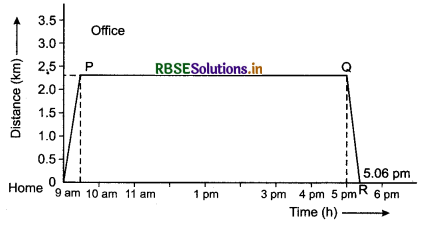
Time at which she leaves home for the office is 9 AM. (x = 0, as shown in figure).
Thus, time at which she reaches her office is 9.30 AM (line OP)(x = 2.5 km). She remains in her office (i.e. at a distance of 2.5 km from her home) from 9.30 AM to 5 PM, given by line PQ in figure.
From office to home: Time at which she leaves her office = 5 PM (x = 2.5 km) speed of auto = 25 km.h-1; distance = 2.5 km. Thus, time taken to reach the home by auto is
t = \(\frac{2.5 \mathrm{~km}}{25 \mathrm{~km} \cdot \mathrm{h}^{-1}}=\frac{1}{10}\)h = 6 min.
So, the time at which the reaches her home is 5.06 PM (point R in figure).
∴ x - t graph of her motion is shown in figure.
Question 3.4.
A drunkard walking in a narrow lane takes 5 steps forward and 3 steps backward, followed again by 5 steps forward and 3 steps backward, and so on. Each step is 1 m long and requires 1 s. Plot the x - t graph of his motion. Determine graphically and otherwise how long the drunkard takes to fall in a pit 13 metre away from the start.
Answer:
(a) Graphical method: Taking the starting point as origin, the positions of the drunkard at various instants of time are given in following table.
|
t(s) |
0 |
5 |
8 |
13 |
16 |
21 |
24 |
29 |
32 |
37 |
|
x(m) |
0 |
5 |
2 |
7 |
4 |
9 |
6 |
11 |
8 |
13 |
The position-time (x - t) graph for the motion of the drunkard is shown in figure. As is obvious from graph that the drunkard would take 37 s to fall in the pit 13 m away from the starting point.
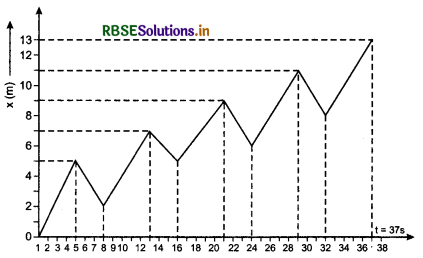
(b) Analytical method: In each forward motion of 5 steps and in backward motion 3 steps, net displacement covered = 5 - 3 = 2 m and time taken = 5 + 3 = 8s
∴ Time required to cover a distance of 8 m
= \(\frac{8}{2}\) x 8 = 32 s
Remaining distance of pit = 13 - 8 = 5 m
In next 5 s as he moves 5 steps forward, he will fall into the pit
∴ Total time taken = 32 + 5 = 37 s

Question 3.5.
A jet airplane travelling at the speed of 500 kmh-1 ejects its products of combustion at the speed of 1500 kmh-1 relative to the jet plane. What is the speed of the latter with respect to an observer on the ground?
Answer:
Suppose the direction of gases is positive. Relative velocity of gases (g) with respect to jet.
vgj = vg - vj
where vg = velocity of gases with respect to ground
vj = velocity of jet with respect to ground
= 500 km-h-1
Vgj = -1500 km-h-1
∴ vg = vgj + vj
= -1500 + 500
= -1000 km-h-1
Negative sign shows that the direction of gases is opposite to that of the jet plane.
∴ Speed of gases = 1000 kmh-1
Question 3.6.
A car moving along a straight highway with speed of 126 kmh-1 is brought to a stop within a distance of 200 m. What is the retardation of the car (assumed uniform), and how long does it take for the car to stop?
Answer:
Given: u = 126km.h-1 = 126 x \(\frac{5}{18}\) = 35 ms-1
v = 0, S = 200 m; a = ?; t = ?
Using equation of motion v2 = u2 + 2aS, we have
0 = 35 x 35 + 2 x a x 200
or a = -\(\frac{35 \times 35}{2 \times 200}\) = -3.06 ms-2
∴ Retardation = 3.06 ms-2
Now using equation v = u + at, we have
0 = 35 - 3.06 x t
∴ t = \(\frac{35}{3.06}\) = 11.4 s
Question 3.7.
Two trains A and B of length 400 m each are moving on two parallel tracks with a uniform speed of 72 kmh-1 in the same direction, with A ahead of B. The driver of B decides to overtake A and accelerates by 1 ms-2. If after 50 s, the guard of B just brushes past the driver of A What was the original distance between them?
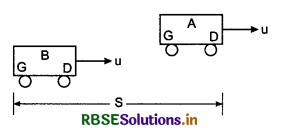
Answer:
Relative inital speed of trains ur = 0
Relative acceleration ar = 1 ms-2
Length of each train = 400 m
t = 50 s.
If total relative distance covered by train B, is S then
S = urt + \(\frac{1}{2}\) art2
= 0 + \(\frac{1}{2}\) x 1 x 50 x 50
= 25 x 50 = 1250 m
Inital distance between the trains = S - 2l
= 1250 - (400 + 400) = 1250 - 800
= 450 m
Question 3.8.
On a two-lane road, car A is travelling with a speed of 36 kmh-1. Two cars B and C approach car A in opposite directions with speed of 54 kmh-1 each. At a certain instant, when the distance AB is equal to AC, both being 1 km; B decides to overtake A before C does. What minimum acceleration of car B is required to avoid the accident?
Answer:
Motion of all three cars is shown in figure. Velocities of cars A,B and C are vA, vB and vC respectively. Suppose, cars A and B are moving in + X-direction and car C is moving in -X-direction. According to question.
vA = 36km.hr-1 = 36 x \(\frac{5}{18}\) = 10 ms-1
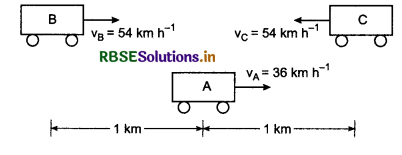
vB = 54 km.hr-1 = 54 x \(\frac{5}{18}\) = 15 ms-1
vC = -54 km.hr-1 = -54 x \(\frac{5}{18}\) = -15 ms-1
Relative velocity of car B w.r.t. car A
vBA = vB - vA = 15 - 10 = 5 ms-1
Relative velocity of car C. w.r.t. car A
vCA = vC - vA = -15 - 10 = -25 ms-1
Here negative sign indicates that vCA is in -X-direction. If t be the time taken to cover distance BC (= 1 km = 1000 m) then
t = \(\frac{1000 \mathrm{~m}}{25 \mathrm{~ms}^{-1}}\) = 40s
If car B overtakes car A before car C, then car B should be accelerated such that distance travelled by car A i.e. AB = 1000 m, with speed of 5 ms-1 and it should take some less time than 40 s. Therefore, from
formula S = ut + \(\frac{1}{2}\) at2
1000 = 5 x 40 + \(\frac{1}{2}\) a x (40)2
or 1000 = 200 + 800 a
or 800 a = 1000 - 200 = 800
∴ a = \(\frac{800}{800}\) = 1 ms-2

Question 3.9.
Two towns A and B are connected by a regular bus service with a bus leaving in either direction every T minutes. A man cycling with a speed of 20 kmh-1 in direction A to B notices that a bus goes past him every 18 min. in the direction of his motion, and every 6 min in the opposite direction. What is the period T of the bus service and with what speed (assumed constant1) do the buses ply on the road?
Answer:
Suppose the velocity of each bus is v km.h-1 and it is uniform.
T min = \(\frac{T}{60}\) hour; the distance covered by the bus in this time = v.(\(\frac{T}{60}\)) km.
When the bus moving from A to B, crosses the cycle, then
The velocity of bus with respect to cycle = v - 20
The time taken by bus to eatch the cycle = 18 min = \(\frac{18}{60}\)hr.
∵ Distance = velocity x time
∴ \(\frac{v T}{60}=(v-20) \times \frac{18}{60}\)
or v - 20 = \(\frac{v T}{18}\) ............................(1)
When bus crosses the cycle moving from B to A then relative velocity = v + 20
In this situation time taken = 6 min = \(\frac{6}{60}\) hr.
Again, Distance = velocity x time
∴ \(\frac{v T}{60}=(v+20) \times \frac{6}{60}\)
∴ v + 20 = \(\frac{v T}{60}\) ..........................(2)
From equations (1) and (2), we have
\(\frac{v+20}{v-20}=\frac{18}{6} \) = 3
v + 20 = 3v - 20
20 + 60 = 3v - v
80 = 2v
v = \(\frac{80}{2}\) = 40 km/h
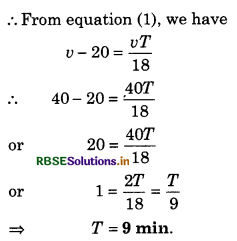
Question 3.10.
A player throws a ball upwards with an initial speed of 29.4 ms-1.
(a) What is the direction of acceleration during the upward motion of the ball?
(b) What are the velocity and acceleration of the ball at the highest point of its motion?
(c) Choose the x = 0 m and t = 0 s to be the location and time of the ball at its highest point, vertically downward direction to be the positive direction of x-axis, and give the signs of position, velocity and acceleration of the ball during the upward and downward motion.
(d) To what height does the ball rise and after how long does the ball return to the player’s hands? (Take g = 9.8 ms-2 and neglect air resistance).
Answer:
(a) The ball moves under gravity throughout its motion. Therefore the direction of acceleration is vertically downwards.
(b) The velocity of the ball at highest point is zero and acceleration is 9.8 ms-2 vertically downwards.
(c) Since the ball remains between highest point and ground therefore during vertically upward and downward motion x > 0 i. e. x is positive.
During vertically upward motion velocity is negative, i.e. v < 0 and during vertically downward motion velocity is positive i. e, v > 0 but acceleration
always remains positive i.e. a = +g = +9.8 ms-2
(d) For upwards motion
u = -29.4 ms-1; a = +9.8 ms-1; S = -H (height of highest point)
v = 0
∴ Using equation v2 = u2 + 2aS
0 = (-29.4)2 + 2 x 9.8 x (-H)
or H = \(\frac{29.4 \times 29.4}{2 \times 9.8}\) = 44.1 m
Now using equation v = u + at
0 = -29.4 + 9.8 x t
∴ t = \(\frac{29.4}{9.8}\) = 3 s
The same time will be taken by ball during its downward journey.
∴ Total time of journey = 3 + 3 = 6 s
Question 3.11.
Read each statement given below carefully and state with reasons and examples, if it is true or false: A particle in one dimensional motion.
(a) with zero speed at an instant may have non-zero acceleration at that instant.
(b) with zero speed may have non-zero velocity.
(c) with constant speed must have zero acceleration.
(d) with positive value of acceleration must be speeding up.
Answer:
(a) True: When an object is projected vertically upwards, then at highest point its velocity become zero but it is under acceleration due to gravity which is vertically downward.
(b) False: Because velocity = speed + direction. Therefore on speed becoming zero, its velocity will also become zero.
(c) True: Since v = constant, therefore acceleration, a = \(\frac{d v}{d t}\) = 0
(d) False: When a particle is projected vertically upwards, then its speed decreases but acceleration due or gravity acting on it remains constant (taking its direction positive). On the other hand if object moves on smoth surface then meaning of positive acceleration is that speed is increasing.
Question 3.12.
A ball is dropped from a height of 90 m on a floor. At each collision with the floor the ball loses one tenth of its speed. Plot the speed-time graph of the motion between t = 0 to t = 12 s.
Answer:
(i) Time taken by the ball to fall through a height of 90 m is obtained as follows:
∵ S = ut + \(\frac{1}{2}\) at2
∴ 90 = 0 + \(\frac{1}{2}\) x 9.8 x t2
or t2 = \(\frac{90}{4.9} \Rightarrow t=\sqrt{\frac{90}{4.9}}=\sqrt{\frac{900}{49}}=\frac{30}{7}=4.3 \mathrm{~s}\)
or t = 4.3 s
Now the velocity with which the ball strikes the ground
v = u + at
v = 4 + 9.8 x \(\frac{30}{7}\) = 42 ms-1
From t = 0 to t = 4.3 s, the speed v ∝ t because acceleration g remains constant.
In this duration the speed increases linearly with time from 0 to 42 ms-1 during the downward motion of the ball and this speed-time variation has been shown by striaght line OA in figure.
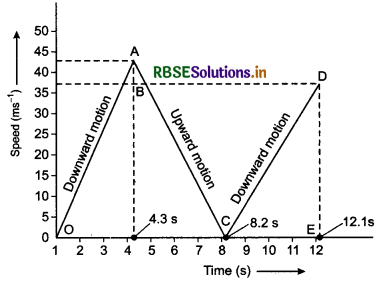
(ii) At first collision with floor the speed lost by the ball
= \(\frac{1}{10}\) x 42 = 4.2 ms-1
Thus the ball rebounds with speed of 42 - 4.2 = 37.8 ms-1. For the further upward motion the speed at any instant t is given by
v(t) = v(0) - gt
or v(t) = 37.8 - 9.8t
Now the speed decreases linearly with time and becomes zero after time
t = \(\frac{37.8}{9.8}\) = 3.9 s
Thus the ball reaches the highest point again after time t = 4.3 + 3.9 = 8.2 s from the start. Straight line BC rpresents this variation in the speed-time graph.
(iii) At highest point, speed of ball is zero. It again starts falling. At any istant t, its speed is given by
v(t) = 0 + gt = 9.8t
Again the speed of the ball increases linearly with time t from 0 to 37.8 ms-1 (initially speed of the presious upward motion) in the next time-interval of 3.98. Total time taken from start = 4.3 + 3.9 + 3.9 = 12.1s This part of motion has been shown by straight line (1).
Here we have assumed a negligible time of collision between ball and the floor.
Question 3.13.
Explain clearly, with examples, the distinction between:
(a) magnitude of displacement (some times called distance) over an interval of time and the total length of path covered by a particle over the same interval, (b) magnitude of average velocity over an interval of time, and the average speed over the same interval. [Average speed of a particle over an interval of time is defined as the total path length divided by the time interval].
Show in both (a) and (b) that the second quantity is either greater than or equal to the first. When is the equality sign true? [For simplicity consider, one dimensional motion only].
Answer:
(a) Length of path actually adopted by a moving object is called ‘distance’ while minimum distance between initial and final positions is called ‘displacement’.
Suppose an object starts moving from A to B and after t time it returns to A If AB = S then distance = S + S = 2S
Displacement = AB - BA = 0 (zero)
(b) Taking the case of (a),
Average speed = \(\frac{\text { Totaldistance }}{\text { Totol time }}=\frac{S+S}{t}=\frac{2 S}{t}\)
Average velocity = \(\frac{\text { Netdisplacement }}{\text { Time }}=\frac{0}{t}\) = 0 (zero)
In both above parts (a) and (b), first quantity is greater than second.
But if motion takes place along straight line without changing direction then both quantities in (a) and (b) will be equal.
Question 3.14.
A man walks on a straight road from his home to a market 2.5 km away with a speed of 5 kmh-1. Finding the market closed, he instantly turns and walks back home with a speed of 7.5 kmh-1. What is the
(a) magnitude of average velocity, and
(b) average speed of the. man over the interval time (i) 0 to 30 min (ii) 0 to 50 min (iii) 0 to 40 min?
[Note: You will appreciate from this exercise why it is better to define average speed as total path length divided by time, and not as magnitude of average velocity. You would not like to tell the tired man on his return home that his average speed was zero.]
Answer:
Distance of market from home = 2.5 km.
Speed from home to marked = 5 km-h-1
∴ Time taken by the man from home to market
t1 = \(\frac{\text { distance }}{\text { speed }}=\frac{2.5 \mathrm{~km}}{5 \mathrm{~km} \cdot \mathrm{h}^{-1}}=\frac{1}{2}\) hr = 30 min.
Speed from market to home = 7.5 km.h-1
∴ Time taken from market to home
t2 = \(\frac{2.5 \mathrm{~km}}{7.5 \mathrm{~km}^{-1} \mathrm{~h}^{-1}}=\frac{1}{3}\) h = 20 min.
∴ Total time taken by man in returning home
t = t1 + t2 = 30 + 20 = 50 min.
(i) Upto 0 to 30 min:
Average velocity = \(\frac{\text { displacement }}{\text { time }}=\frac{2.5}{\frac{1}{2}}\)
= 5 kmh-1
Average speed = \(\frac{\text { distance }}{\text { time }}=\frac{2.5}{\frac{1}{2}}\) = 5 kmh-1
Thus it is clear that in lineaer motion with changing the direction average velocity and average speed both are equal.
(ii) In interval from 0 to 50 min:
Displacement = 0
∴ Average velocity = \(\frac{0 \mathrm{~km}}{50 \mathrm{~min}}\) = 0 (zero) and average speed
= \(\frac{\text { Total distance }}{\text { Time }}=\frac{(2.5+2.5) \mathrm{km}}{50 \mathrm{~min}}\)
= \(\frac{5 \mathrm{~km}}{50 / 60 \mathrm{~m}}=\frac{5}{\frac{5}{6}}\) = 6 km.h-1
Thus it is clear that in this case average velocity is zero but average speed is not zero.
(iii) In interval from 0 to 40 min: During this period man is in his return journey and is on the way. In 30 min. he reaches market situated at 2.5 km from his home. During return journey the distance covered in 10 min the speed of 7.5 km.h-1,
= 7.5x \(\frac{10}{60}=\frac{7.5}{6}\) = 1.25 km
∴ Displacement = 2.5 - 1.25 = 1.25 km and distance = 2.5 + 1.25 = 3.75 km
∴ Average velocity
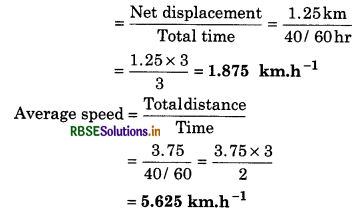
Question 3.15.
In exercises 3.13 and 3.14 we have carefully distinguished between average speed and magnitude of average velocity. No such distinction is necessary when we consider instantaneous speed and magnitude of velocity. The instantaneous speed is always equal to the magnitude of instantaneous velocity, Why?
Answer:
Instantaneous velocity \(\vec{v}=\frac{\vec{d} s}{d t}\) = instantaneous speed + direction, where \(\overrightarrow{d s}\) is infinitesimal small displacement in infinitesimal small time interval dt.
Direction does not change in infinitesimal small time, therefore the magnitude of instantaneous velocity is equal to instantaneous speed.

Question 3.16.
Look at the graphs (a) to (d) (n figure) carefully and state with reasons, which of these cannot possibly represent one dimensional motion of a particle.
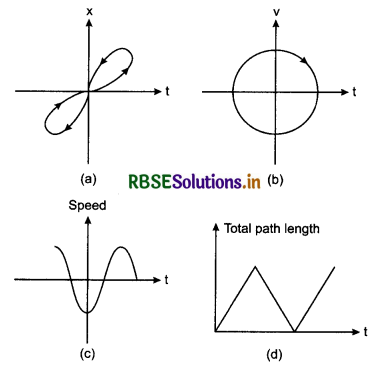
Answer:
(a) In this graph, particle is in two position at the same time which is impossible, therefore graph (a) can not represent one dimensional motion.
(b) In this graph, there are two velocities at the same time (positive and negative velocities). Therefore this graph (b) also cannot represent one dimensional motion.
(c) In this graph speed has been shown negative, which is not possible, therefore this graph (c) also cannot represent one dimensional motion.
(d) In this graph, total path length is changing with increasing time which is impossible, therefore this graph (d) also cannot represent one dimensional motion.
Question 3.17.
Given figure show the x - t plot of one-dimensional motion of a particle. Is it correct to say from the graph that the particle moves in a straight line for t < 0 and on a parabolic path for t > 0? If not, suggest a suitable physical context for this graph.
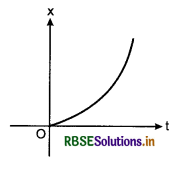
Answer:
For t < 0, the particle is at rest because at t < 0 its position remains at x = 0
For t > 0, the x - t graph is variable with increasing slope. It is possible only when the motion of particle is uniformaly accelerated.
∵ x = ut + \(\frac{1}{2}\) at2
If u = 0, then x = \(\frac{1}{2}\) at2
or x ∝ t2 (This is equation of parabola)
Therefore this is not correct to say that at t < 0, the particle moves in straight line becuase at t < 0, the particle is at rest. For t > 0 because a position-time (x - t) graph does not represent the trajectory of a moving particle.
This graph can represent the motion of a freely falling particle dropped from a tower when we take its initial position as x = 0 at t = 0.
Question 3.18.
A police van moving on a highway with a speed of 30 kmh-1 fires a bullet at a thief s car speeding away in the same direction with a speed of 192 kmh-1. If the muzzle speed of the bullet is 150 ms-1 with what speed does the bullet hit the thiefs car? [Note: Obtain that speed which is relevant for damaging the thiefs car]
Answer:
Suppose the speed of police van is vp and that of thiefs car is vT, muzzle velocity mean the relative velocity of bullet with respect to gun or police van), let it be vBp.
Given: vp = 30km.h-1 = 30 x \(\frac{5}{18}\) = \(\frac{25}{3}\) ms-1
vT = 192 km. h-1 = 192 x \(\frac{5}{18}\) ms-1 = \(\frac{160}{3}\) ms-1
VBP = 150 ms-1
Since all the velocities are in same direction if speed of bullet with respect to Earth be vB, then
∴ vBP = vB - vP
or vB = vBP + vP = 150 + \(\frac{25}{3}=\frac{475}{3}\) ms-1
∴ Relative velocity of bullet with respect to theif's car
vBT = vB - vT = \(\frac{475}{3}-\frac{160}{3}\)
or vBT = 105 ms-1
Question 3.19.
Suggest a suitable physical situation for each of the following graphs. (See fig below)
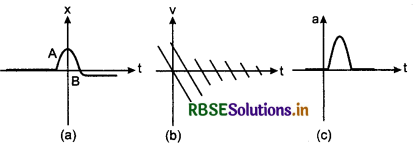
Answer:
(a) The given x - t graph represents that the ball is initially (i.e. at t = 0) is at rest (i.e. x = 0). After this the ball achieves a uniform velocity and ball changes its direction after some time and ultimately becomes at rest.
Physical reference: Initially the ball is at rest on a floor. It is given constant velocity by kicking it. It strikes a wall and returns with smaller speed and ultimately becomes at rest after striking the other wall.
(b) The given (v - t) graph indicates that the direction of ball changes again and again and after each change its velocity goes on decreasing.
Physical reference: A ball thrown vertically upward, strikes the ground again and again and its velocity decreases upto some extent in each collission and ultimately it stops.
(c) The given graph (c) indicates that initially, the acceleration is zero and accelration is obtained for short time interval and just after it is converted in retardation and ultimately again becomes zero.
Physical reference: A cricket ball moving with uniform velocity strikes the bat for short time and returns back.

Question 3.20.
Given figure gives the x - t plot of a particle executing one dimensional simple harmonic motion. (You will learn about this motion in more detail in Chapter 14. Give the signs of position, velocity and acceleration variables of the particle at t = 0.3 s, 1.2 s, -1.2 s.
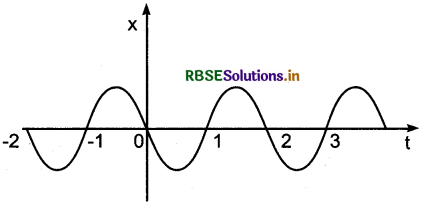
Answer:
When the partaicle is above time-axis,then its position is positive and being below time axis its position is negative.
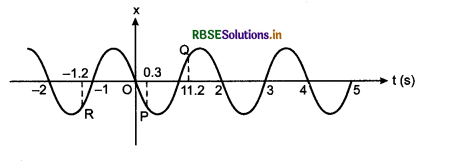
When x incresaes with increasing time, then velocity is positive but when x decreases with increasing time, then velocity is negative i.e. when velocity decreases then its velocity is negative.
When the slope of x - t graph increases then its acceleration is positive and with decreasing slope, the acceleration is negative.
At t = 0.3 s, (point P) x is negative, v is negative and a is positive.
At t = 1.2 s, (point Q), x and v are positive but a is negative.
At t = - 1.2 s (point R), x is negative but v and a are positive.
Question 3.21.
Given figure gives the x - t plot of a particle in one dimensional motion. Three different equal intervals of time are shown. In which interval is the average speed greatest and in which is it the least? Give the sign of average velocity for each interval.
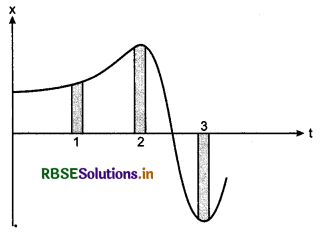
Answer:
Average speed of a particle is equal to slope of the line joining the initial and final points of an interval of time. In given graph, for interval ‘3' the slope is maximum and in interval ‘2’ slope is minimum. Therefore, average speed in interval ‘3’ is maximum and in interval ‘2’ it is minimum.
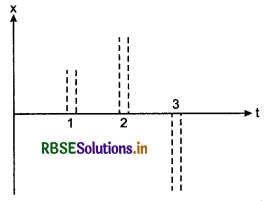
In intervals '1' and ‘2’,the slope is positive while in interval ‘3’ slope is negative. Therefore average velocity in interval '1' and ‘2’ is positive while in interval ‘3’ it is negative.
Question 3.22.
Given figure gives a speed-time graph of a particle in motion along a constant direction. Three equal intervals of time are shown. In which interval is the average acceleration greatest in magnitude? In which interval is the average speed greatest. Choosing the positive direction as the constant direction of motion give the signs of v and a in the three intervals. What are the accelerations at the point A,B,C and D?
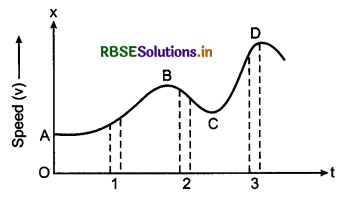
Answer:
Average acceleration of a particle is equal to slope of straight line joining the initial and final points of given time interval. In given time intervals for interval ‘2’, the slope of the curve is maximum but negative. Therefore magnitude of average acceleration is maximum for time interval ‘2’.
Aveage speed in given time interval = \(\frac{v_1+v_2}{2}\)
It is clear from the graph that magnitudes of v1 and v2 are maximum for time interval '3'. Therefore average speed is maximum for time inteval ‘3’.
Since speed is always positive, therefore it is positive in all three intervals of time.
In interval ‘1’ slope of v - t graph is positive, therefore ‘a’ will be positive.
In time interval ‘2’ the slope of v - t graph is negative, therefore ‘a’ is negative.
In time interval ‘3’, the slope of graph is positive, therefore ‘a’ is positive.
Instantaneous acceleration of particle is equal to slope of tangent drawn an the v - t graph at the time. Therefore at points A,B,C and D, the tangents drawn are parallel to time axis. Hence the slope of the graph at these points is zero. Therefore acceleration at these points is zero.
Additional Exercises
Question 3.23.
A three wheeler starts from rest, accelerates uniformly with 1 ms-2 on a straight road for 10 s, and then moves with uniform velocity. Plot the distance covered by the vehicle during nth second (n = 1, 2, 3, ..........) versus n. What do you expect this plot to be during accelerated motion: a straight line or parabola?
Answer:
Suppose the direction of motion of three wheeler is positive X-axis. If xn he the distance travelled in nth second, then for uniformly accelerated motion,
xn = u + \(\frac{1}{2}\) a(2n - 1)
Given: u = 0; a = 1 ms-1
∴ xn = 0 + \(\frac{1}{2}\) a(2n - 1)
or xn = \(\frac{1}{2}\) x 1(2n - 1)
or, xn = n - \(\frac{1}{2}\)
Therefore substituting n = 1, 2, 3, 4, ............................
|
n |
1 |
2 |
3 |
4 |
5 |
6 |
7 |
8 |
9 |
10 |
|
xn |
0.5 |
1.5 |
2.5 |
3.5 |
4.5 |
5.5 |
6.5 |
7.5 |
8.5 |
9.5 |
velocity after 10s, v = u + at
∴ v = 0 + 1 x 10 = 10 ms-1
After 10 s velocity becomes constant, therefore three wheeler travels 10 m in each second and graph between x and n is shown in diagram -xn is accelerated distance in nth s. During accelerated motion xn - n graph is a straight line. If graph is plotted between x and t, then it becomes parabolic figure
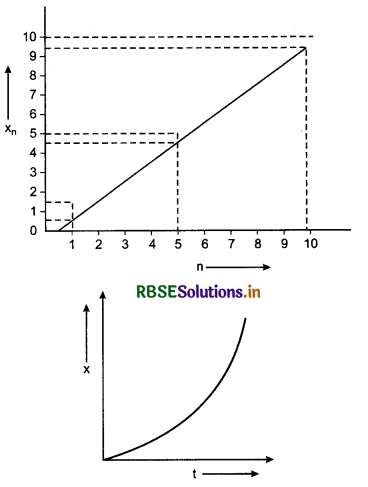
Question 3.24.
A boy standing on a stationary lift (open from above) throws a ball upwards with the maximum initial speed he can, equal to 49 ms-1. How much time does the ball take to return to his hands? If the lift starts moving up with a uniform speed of 5 ms-1 and the boy again throws the ball up with the maximum speed he can, how long does the ball take to return to his hands?
Answer:
When lift is stationary: Considering vertically downward direction positive,
u = -49 ms-1; a = +g = + 9.8 ms-2
If the ball returns to the hands of the boy in time T, then its displacement S = 0. Therefore from equation
S = ut + \(\frac{1}{2}\) at2
We have 0 = -49T + \(\frac{1}{2}\) x 9.8 T2
or 4.9T2 = 49T
or 4.9T = 49
∴ T = \(\frac{49}{4.9}\) = 10 s
i.e. the ball returns to hands of the boy after 10 s.
When the ball moves upward with uniform velocity:
In this situation the velocity of lift with respect to Earth.
u0 = 5 ms-1
If T be the time taken by ball in returning to hands of the boy, then vertical displacement of the ball
S = u0T = -5T
Relative velocity of the ball with respect to Earth
uB = ur + u0 = (-49 - 5) = -54 ms-1
From equation s = ut + \(\frac{1}{2}\) at2
-5T = - 54T + \(\frac{1}{2}\) x 9.8T2
or -5 = -54 + 4.9T
or 4.971 = -5 + 54 = 49
or T = \(\frac{49}{4.9}\) = 10s
Thus in both situations, the time taken by ball = 10 s.
Question 3.25.
On a long horizontally moving belt (figure) a child runs to and fro with a speed of 9 kmh-1 (with respect to the belt) between his father and mother located 50 m apart on the moving belt. The belt moves with a speed of 4 kmh-1. For an observer on a stationary platform outside the belt, what is the
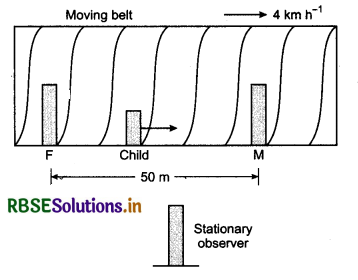
(a) Speed of the child running in the direction of motion of the belt?
(b) Speed of the child running opposite to the direction of motion of the belt?
(c) Time taken by the child in (a) and (b)? Which of the answers alter if motion is viewed by one of the parents?
Answer:
Suppose velocity of the belt is vB and the velocity of child with respect to belt is vCB.
Given: vB = 4km.h-1 and vCB = 9km.h-1.
(a) When child runs in the direction of motion of the belt. Suppose the velocity of the child with respect to stationary observer is vc, then
vCB = vC - vB
⇒ vC = vCB + vB = 9 + 4 = 13 kmh-1
(b) When child runs in opposite direction of motion of the belt: In this situation
vCB = vC - vB
⇒ vC = vCB + vB = -9 + 4 = 5 kmh-1
(c) Distance between parents = 50 m Since parents are on the moving belt, therefore the speed of the child with respect to parents = 9 km.h-1
= 9 x \(\frac{5}{18}\) = 2.5ms-1
If t be the time taken by child in (a) and (b), then
t = \(\frac{\text { distance }}{\text { time }}=\frac{50}{2.5}\) = 20 s
On viewing by any parent (mother or father), the speed of the child in both situations = 9km. h-1
Thus answer (c) will remain unchanged.

Question 3.26.
Two stones are thrown up simultaneously from the edge of a cliff 200 m high with initial speeds of 15 ms-1 and 30 ms-1. Verify that the graph shown in figure correctly represents the time variation of the relative position of the second stone with respect to the first. Neglect air resistance and assume that the stones do not rebound after hitting the ground. Take g = 10 ms-2. Give the equations for the linear and curved parts of the plot.
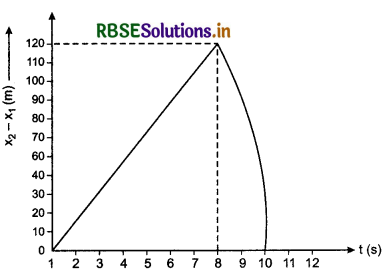
Answer:
For first stone: Suppose for measurement position of the ground level is origin. Therefore initial position.
x0 = 200 m
Initial velocity u = v(0) = 15 ms-1; a = -g = -10 ms-2
Using relation,
x(t) = x0 + ut + \(\frac{1}{2}\) at2
We have x1(t) = 200 + 15t - \(\frac{1}{2}\) x 10t2
x1(t) = 200 + 15t - 5t2 .....................(1)
When first stone strike the ground then x1(t) = 0
∴ 200 + 15t - 5t2 = 0
or 5t2 - 15t - 200 = 0
or t2 - 3t - 40 = 0
or t2 - 8t + 5t - 40 = 0
or t(t - 8) + 5(t - 8) = 0
or (t - 8)(t + 5) = 0
∴ t = 8 and t = -5 which is not acceptable
∴ t = 8 s
For second stone: Initial velocity u = v0 = 30 ms-1
∴ x2(t) = x0 + ut + \(\frac{1}{2}\) at2
or x2(t) = 200 + 30t - \(\frac{1}{2}\) x 10t2 ...................(2)
When second stone strikes the ground, then x2(t) = 0
∴ 0 = 200 + 30t - 5t2
or 5t2 - 30t - 200 = 0
or t2 - 6t - 40 = 0
or t2 - 10t + 4t - 40 = 0
or t(t - 10) + 4(t - 10) = 0
or (t - 10)(t + 4) = 0
∴ t = 10 and t = -4 which is not acceptable.
∴ t = 10 s
Relative position of second stone with respect to first stone,
x2 - x1 = 15t ............................(3)
It is clear that graph between (x2 - x1) and t is straight line. This equation is appropriate for 8 s only. After 8 s only second stone is in motion and this motion is described by equation (2).
x2 = 200 + 30t - 5t2 ...................(4)
This equation is quadratic equation. Therefore given curve satisfies equation (4) between 8 s to 10 s.
Question 3.27.
The speed time graph of a particle moving along a fixed direction, is shown in figure Obtain the distance traversed by the particle between (a) t = 0 s to 10 s. (b) t = 2 s to 6s. What is the average speed of the particle over the intervals in (a) and (b).
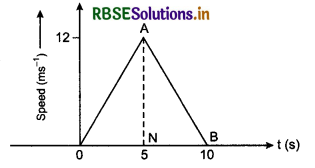
Answer:
(a) The distance travelled is obtained by area covered between graphical line and time-axis in speed-time graph. Therefore distance travelled from 0 s to 10 s
= Area of ∆ OAB
= \(\frac{1}{2}\) x OB x AN = \(\frac{1}{2}\) x 10 x 12 = 60m
= 60m
(b) Acceleration of the particle from 0 to 5s
a1 = slope of line OA
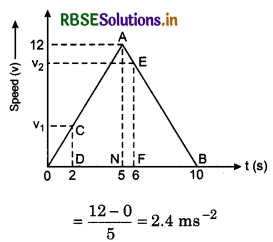
∴ Velocity at 2s
v1 = u + a1t
= 0 + 2.4 x 2 = 4.8 ms-1
Acceleration from 5 to 10 s
a2 = Slope of line AB
= \(\frac{v_2-v_1}{t_2-t_1}=\frac{0-12}{10-5}\)
= -\(\frac{12}{5}\) = -2.4 ms-2
∴ Speed of the particle at 6s
v2 = v + a2t = 12 - 2.4(6 - 5) = 9.6 ms-1
The distance travelled by the particle from 2 s to 6 s
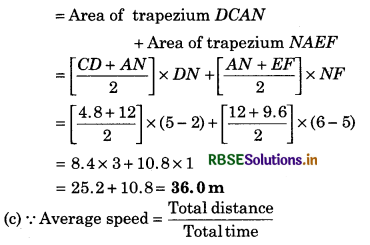
∴ Average speed from 0 s to 10 s,
vav = \(\frac{60}{10}\) = 6 ms-1
and average speed from 2 to 6 s
vav = \(\frac{36}{4} \) = 9 ms-1

Question 3.28.
The velocity-time graph of a particle in one dimensional motion is shown in figure. Which of the following formulae are correct for describing the motion of the particle over the time interval t1 to t2:
(a) x(t2) = x(t1) + v(t1) (t2 - t1) + \(\frac{1}{2}\) a(t2 - t1)2
(b) v(t2) = v(t1) + a(t2 - t1)
(c) vaerage = \(\frac{x_{\left(t_2\right)}-x_{\left(t_1\right)}}{\left(t_2-t_1\right)}\)
(d) aaverage = \(\frac{v_{\left(t_2\right)}-v_{\left(t_1\right)}}{\left(t_2-t_1\right)}\)
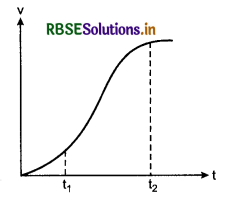
(e) x(t2) = x(t1) + vaverage (t2 - t1) + \(\frac{1}{2}\) aaverage(t2 - t1)2
(f) x(t2) - x(t1) = Area under the v-t curve bounded by the t-axis and the dotted line shown.
Answer:
(a) and (b) graphs between v and t are nonlinear, therefore motion is non-uniformly accelerated. Hence equations (a) and (b) are not correct, because these equations represent kinematic equations for uniform acceleration.
Equation (c) is correct according to definition.
Equation (d) is correct according to definition.
Equation (e) is not correct because average speed is not involved in this formula.
Equation (f) is correct, because area between v - t graph and t-axis provides displacement for all types of linear motions.

- RBSE Class 11 Physics Important Questions Chapter 4 Motion in a Plane
- RBSE Solutions for Class 11 Physics Chapter 15 Waves
- RBSE Solutions for Class 11 Physics Chapter 14 Oscillations
- RBSE Solutions for Class 11 Physics Chapter 13 Kinetic Theory
- RBSE Solutions for Class 11 Physics Chapter 12 Thermodynamics
- RBSE Solutions for Class 11 Physics Chapter 11 Thermal Properties of Matter
- RBSE Solutions for Class 11 Physics Chapter 10 Mechanical Properties of Fluids
- RBSE Solutions for Class 11 Physics Chapter 9 Mechanical Properties of Solids
- RBSE Solutions for Class 11 Physics Chapter 8 Gravitation
- RBSE Solutions for Class 11 Physics Chapter 7 System of Particles and Rotational Motion
- RBSE Solutions for Class 11 Physics Chapter 6 Work, Energy and Power